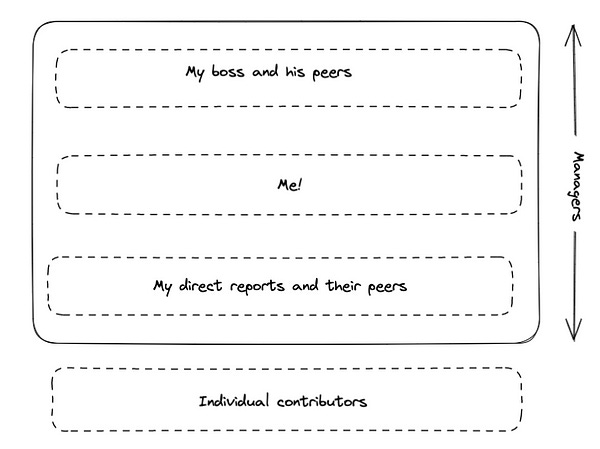- A1 Engineering
- Posts
- The unsexy (but important) role played by middle management
The unsexy (but important) role played by middle management
What having killer managers can help you accomplish
I came across a story in the BBC that wanted to take a different take on middle management in the aptly titled “Why middle managers are often cast as villains”. As a middle manager myself, I would like to second the spirit of that article and provide my own perspective on this topic.
I am the VP of Engineering at an adtech startup that has <100 people and I am quite literally a middle manager.

Amongst other things, one of my jobs as a People Manager has always been “Make sure to unblock your team” aka do whatever it takes so that your team doesn’t feel like they are stuck in the mud with their wheels spinning. However, as my scope of work has increased or gotten clearer, one of my responsibilities is to also ensure that the vision of the company leaders is clearly and transparently communicated to the team and executed without hiccups.
This is where the real need for middle management comes in. The size and scope of “middle” management depends on the size of the company itself. Now is probably the time for the caveats -
You want to make sure the middle managers you have, themselves have the skills or the awareness of what their individual contributors are capable of doing, because that can be a killer combination.
Having pure managers for the sake of having managers, can be a double edged sword. Not having the right people in place might end up gumming up the works even more. This would be an unintended side effect of trying to fix a different problem.
Let's maybe rewind a bit to when you are first thinking of these problems. You really should maintain as much of a flat hierarchy as possible when you are small. That way you can have focused discussions with all parties involved and keep moving the vision forward expediently. Let us assume there is a 15 person company structured like this which has a pretty direct line between founders and individual contributors.

At some point, you are likely going to outgrow this model. Either because you are growing gangbusters and you need to hire people, or because the senior most members (typically the founders) will need to go do other things — like raise capital, or deal with legal or HR related concerns. Typically you start feeling this pain around the 15–20 employee mark if not sooner. This might now leave a vacuum in place. While previously there was a direct line of communication between the founder and the doer, now there is a lack of direction or constant feedback.
One solution is to have the CEO be the flag bearer of the company and have the other 2 co-founders manage all the other people in the company. Now, co-founders also tend to be pretty involved in outward facing activities like pursuing new clients or working with the board on due diligence. Suddenly you are asking 12 people to set up time with 2 people who aren’t really available for internal folks, which creates bottlenecks all around.

Another alternative is to hire/recruit/promote managers who lie between the co founders and individual contributors. These middle managers help achieve the following benefits —
Provide a translation layer — The upper management/founders/CEO/C-Suite layer tend to have very high level (50,000 feet) views and dabble in mile-wide-inch-deep sort of conversations. On the other hand, Individual contributors have very detailed views of granular items and deal with inch-wide-mile-deep sort of discussions. Ensuring these 2 groups of people are able to communicate effectively is the duty of middle managers. Conveying high level vision from upper management to the individual contributors, and likewise, conveying the successes and impediments in the other direction are both key goals for middle managers.
Help look inwards —Middle managers ensure that while the founders are looking outwards, there is someone to look inwards. This guarantees that people in the company are well looked after and their needs are addressed. It allows for the nitty gritty of daily life — or as the phrase goes “Keep the trains on track” — to be accomplished successfully. Whether this is personnel needs, technical wherewithal, or being able to facilitate the solution to a cross-functional problem, effective middle managers help move the needle.
Form a robust peer group — By linking up across the breadth of the organization, middle managers can be very effective at creating super highways of information that enable communication to flow laterally. Besides cultural benefits, this also helps expedite completion of important initiatives. These peer groups can help surface impediments early on in the process. It also provides a cohort that can rely on and learn from each other for mutual benefit.

At the end of the day, its a balance. Having unnecessary layers of management will slow down your company and create organizational bureaucracy or red tape. On the other hand, effective middle managers inserted with strategic precision can help scale your company to new heights.
Reply